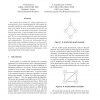Free Online Productivity Tools
i2Speak
i2Symbol
i2OCR
iTex2Img
iWeb2Print
iWeb2Shot
i2Type
iPdf2Split
iPdf2Merge
i2Bopomofo
i2Arabic
i2Style
i2Image
i2PDF
iLatex2Rtf
Sci2ools
PDP
2003
IEEE
2003
IEEE
Scheduling strategies for mixed data and task parallelism on heterogeneous clusters and grids
We consider the execution of a complex application on a heterogeneous "grid" computing platform. The complex application consists of a suite of identical, independent problems to be solved. In turn, each problem consists of a set of tasks. There are dependences (precedence constraints) between these tasks. A typical example is the repeated execution of the same algorithm on several distinct data samples. We use a non-oriented graph to model the grid platform, where resources have different speeds of computation and communication. We show how to determine the optimal steady-state scheduling strategy for each processor (the fraction of time spent computing and the fraction of time spent communicating with each neighbor). This result holds for a quite general framework, allowing for cycles and multiple paths in the platform graph.
Complex Application | Computing Platform | Distributed And Parallel Computing | PDP 2003 | Time Spent Computing |
| Added | 05 Jul 2010 |
| Updated | 05 Jul 2010 |
| Type | Conference |
| Year | 2003 |
| Where | PDP |
| Authors | Olivier Beaumont, Arnaud Legrand, Yves Robert |
Comments (0)

